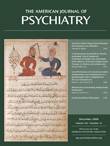Binge Eating Disorder: A Stable Syndrome
Abstract
Objective: This study assessed the stability of binge eating disorder in a community sample. Method: The authors interviewed 888 first-degree relatives of 300 overweight or obese probands (150 with binge eating disorder and 150 with no lifetime eating disorder) who were recruited during a family study. They compared the total duration of illness among relatives with lifetime diagnoses of binge eating disorder (N=131), bulimia nervosa (N=17), and anorexia nervosa (N=18). Results: The mean lifetime duration of binge eating disorder was 14.4 years (SD=13.9), significantly longer than for either bulimia nervosa (mean=5.8 years, SD=9.1) or anorexia nervosa (mean=5.9 years, SD=7.4). These differences changed little when analysis was restricted to female relatives or to relatives of the probands with no lifetime eating disorder. Conclusions: These findings suggest that binge eating disorder is at least as chronic as the well-validated disorders anorexia nervosa and bulimia nervosa and likely represents a stable syndrome.



